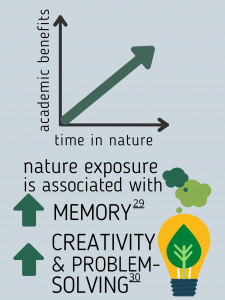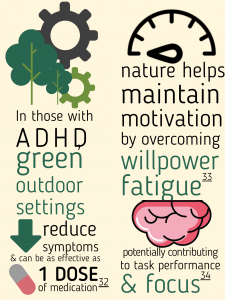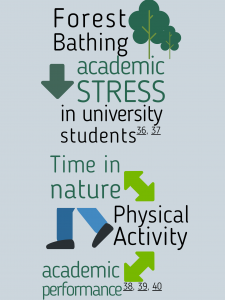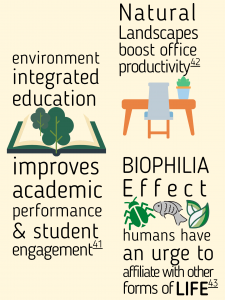Expandable List
 Interestingly, when lessons are performed in nature, performance improves not only for the time being, but also for subsequent lessons underpinning the value of spending time in nature daily28. These benefits apply across tasks types supporting both convergent and divergent thinking. Following nature exposure, improvements in memory as well as creativity and problem solving have been demonstrated29,30. One explanation for the heightened attention is through attention restoration theory which suggests that fatigue caused by directed attention can be overcome by a restorative environment, for instance greenspaces31.
Interestingly, when lessons are performed in nature, performance improves not only for the time being, but also for subsequent lessons underpinning the value of spending time in nature daily28. These benefits apply across tasks types supporting both convergent and divergent thinking. Following nature exposure, improvements in memory as well as creativity and problem solving have been demonstrated29,30. One explanation for the heightened attention is through attention restoration theory which suggests that fatigue caused by directed attention can be overcome by a restorative environment, for instance greenspaces31.
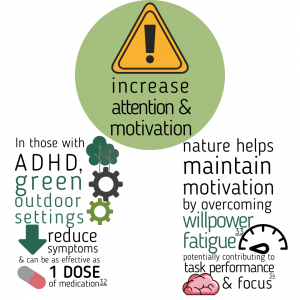 Across settings, participant characteristics and type of nature exposure, acute doses of nature have a positive effect on attention and motivation. Among those with Attention Deficit/Hyperactivity Disorder (ADHD), conducting activities in greenspaces significantly reduced symptoms compared to the same activities in control settings32. In fact, the effects of nature exposure on improving attention were as strong as a dose of medication in reducing the symptoms of ADHD suggesting that nature could reduce the pharmaceutical needs for such individuals32. However, the benefits seem to be experienced by everyone; on a cognitive performance test requiring continued attention, participants who first completed a nature walk performed significantly better than those who walked in an urban environment33 with nature being thought to play a role in maintaining motivation for such tasks34.
Across settings, participant characteristics and type of nature exposure, acute doses of nature have a positive effect on attention and motivation. Among those with Attention Deficit/Hyperactivity Disorder (ADHD), conducting activities in greenspaces significantly reduced symptoms compared to the same activities in control settings32. In fact, the effects of nature exposure on improving attention were as strong as a dose of medication in reducing the symptoms of ADHD suggesting that nature could reduce the pharmaceutical needs for such individuals32. However, the benefits seem to be experienced by everyone; on a cognitive performance test requiring continued attention, participants who first completed a nature walk performed significantly better than those who walked in an urban environment33 with nature being thought to play a role in maintaining motivation for such tasks34.
 The stress reducing benefits of spending time in nature are thought to contribute to improvements in learning as academic stress can hinder cognitive performance35. Some University Students in Toronto have described how nature bathing helped relieve academic stress36 while other studies have demonstrated that even views of nature from a classroom improve academic performance and stress recovery37.
The stress reducing benefits of spending time in nature are thought to contribute to improvements in learning as academic stress can hinder cognitive performance35. Some University Students in Toronto have described how nature bathing helped relieve academic stress36 while other studies have demonstrated that even views of nature from a classroom improve academic performance and stress recovery37.
Studies have consistently shown the benefits of physical activity on enhancing learning as well as the association with academic performance38. Given the link between greenspace, spending time in nature and participating in moderate physical activity, improved learning may be mediated through physical activity39, 40.
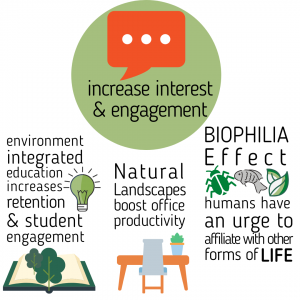 Nature is also thought to improve motivation and interest. Integrating the environment into education has shown huge improvements in student interest, enthusiasm, and engagement in learning activities41 as well as workplace productivity42.
Nature is also thought to improve motivation and interest. Integrating the environment into education has shown huge improvements in student interest, enthusiasm, and engagement in learning activities41 as well as workplace productivity42.
The biophilia effect suggests interacting with life from nature can support wellbeing and satisfaction43. With this in mind, the self-determination theory has supported the role of nature in supporting positive learning experiences44,45.
Not only does spending time in nature have individual benefits but, there are also broader community wide implications. Research suggests that exposure to nature is directly linked with stewardship and pro-environmental behavior46. For youth this extends to the educational sphere where nature-based learning also leads students to be more environmentally engaged citizens going forward47.


